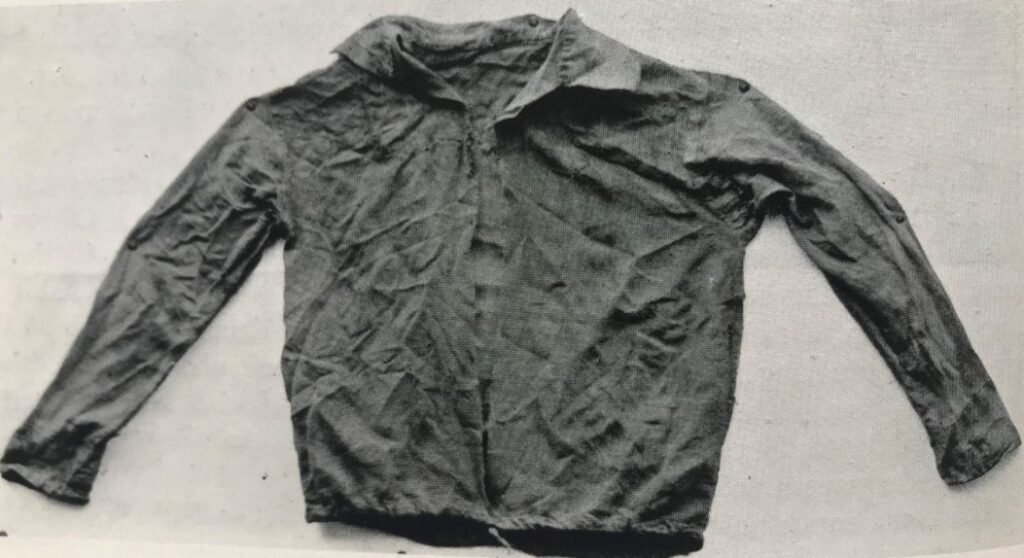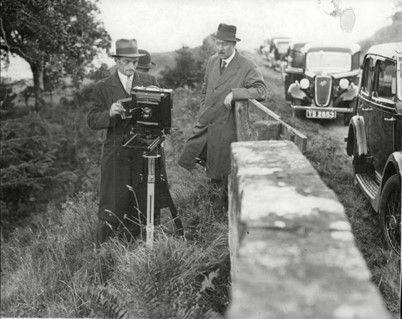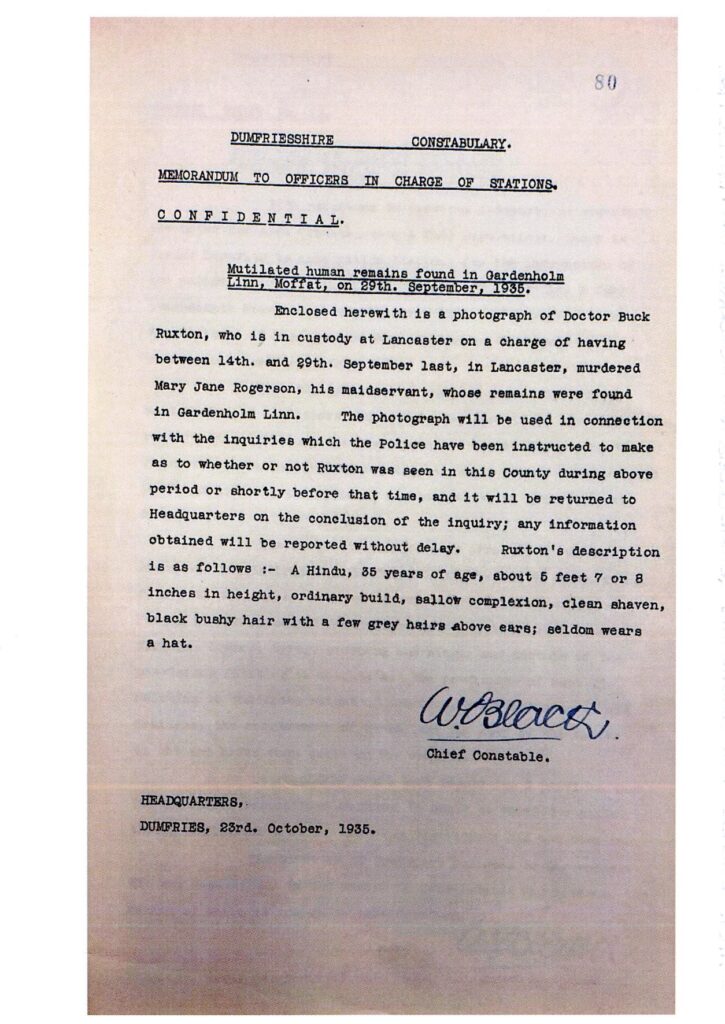Body parts were found in Moffat on 29th September 1935. In searches over the coming days a total of 70 body parts were found, wrapped in sheeting, clothing, and newspaper. Covered in maggots, the stench was overpowering.
Sergeant Sloan had secured the scene and taken detailed notes; he later produced a detailed drawing of Gardenholm Linn.
The following day, the Chief Constable of Dumfriesshire (William Black) called in expert assistance from Glasgow C.I.D and the Crown enlisted the help of forensic specialists and anatomists from the universities of Glasgow and Edinburgh. Over the course of the investigation these included:
| Professor John Glaister | University of Glasgow |
| Dr. Gilbert Millar | University of Edinburgh |
| Professor John Couper Brash | University of Edinburgh |
| Professor Sydney Smith | University of Edinburgh |
| Dr. Llewellyn Godfrey | Radiologist |
| Dr. A.C. W Hutchison | Edinburgh Dental Hospital |
| Detective Constable Thomas Stobie | City of Edinburgh Police |
| Detective Lieutenant Bertie Hammond | City of Glasgow Police |
The incomplete remains were initially thought to be those of a man and a woman.
The dismemberment of the bodies was believed to have been undertaken shortly after death. Parts and features had been removed to make identification of the bodies very difficult and it was concluded that the person or persons responsible had good anatomical knowledge. The body parts were taken to laboratories for investigation.
The newspaper pages were preserved by Sergeant Sloan and the clothing retained.
A priority for the Police was to establish whether the victims were local, and a great deal of work was undertaken to see that all residents could be accounted for. Scotland Yard was approached to ensure a countrywide overview.
Officers continued to search the ravine at Gardenholm Linn, including using bloodhounds. Further remains were found, including by members of the public right up until 4th. November.
The Police believed that the remains were probably dumped in the Linn about the 17th/18 September as the Linn had been in spate that night. They concluded that a motor vehicle must have been involved and that the vehicle may have attracted attention because of the offensive smell. Extensive work was undertaken to check motorists and garages.
Sergeant Sloan managed to dry out the newspaper pages and open them out, with forceps. On 9th October it was established that the newspapers ‘Sunday Graphic and Sunday News’ were part of a ‘slip’ edition of just 3700 copies and distributed around Morecambe. Contact was made with Lancashire Police.
A report had appeared in the ‘Scottish Daily Record’ on 9th October about the disappearance of a young nursemaid, Mary Rogerson, who had vanished 3 weeks previously, from the house of her employer- Dr. Buck Ruxton in Lancaster.
Sergeant Sloan’s wife had, meantime, carefully washed and dried the clothing found with the body parts. Photographs of the blouse and romper suit were taken and shared with the Press.
The Police in Scotland contacted their colleagues in Morecambe and Lancaster and events began to move very quickly indeed. Dr. Ruxton was telling people that his wife, Isabella, had left him and travelled away with Mary Rogerson. A view was beginning to develop, within the Police, that the bodies may be of 2 females and corroborating evidence was being sought. Further work by forensic experts concluded, on 10th, October, that both bodies were female.
The detail that was emerging included:
- The 2 women in Lancaster had been missing since 14th September.
- The bodies had been deposited in Moffat before 19th September
- The dismemberment of the bodies would have taken around 8 hours.
- Care had been taken to remove all possible marks for identification.
- The 2 bodies were both females.
- 2 women of roughly the same physical description as the bodies were missing from Lancaster.
- The husband and employer of the 2 women was an experienced doctor and surgeon, with the skill and knowledge to dissect the bodies.
- Cause of death appeared to be by Asphyxia (strangulation) in relation to Body No. 2 and Head Injury in relation to Body No 1.
- The troubled and volatile relationship between Ruxton and his partner.
- Sergeant Sloan had continued investigations about traffic movements and on 10th October he received a report that Dr. Ruxton had been involved in a traffic accident in Kendal on 17th September at 12.45 pm. He was described as being ‘wildly excited’ and both of his hands were bandaged.
- The blouse, found at Gardenholm Linn, was identified by Mary Rogerson’s mother as being Mary’s.
- The romper suit was positively identified as part of a bundle of clothing, given to Mary.
- Lancaster police were making investigations and had statements from people about Dr. Ruxton removing heavily bloodstained carpets and clothing from his home.
On 13th October Buck Ruxton was charged with Mary’s murder. Taken into custody, he would not return to his home or children again.
Lancaster Police now assumed the lead role in the case, with the continued involvement of the Glasgow Police, because of their expertise in finger printing, and Edinburgh Police photographic experts. And of course, the forensic teams at the Universities of Glasgow and Edinburgh remained key players.
The task now was to clearly identify the bodies as being those of Isabella Ruxton and Mary Jane Rogerson.
- Detailed and innovative work on Fingerprinting, described elsewhere in this Exhibition, was undertaken. This involved taking prints from the dismembered bodies and matching them against ‘chance’ prints at Ruxton’s house.
- Establishing time of death was achieved by pioneering entomology work – ‘The Ruxton Maggots’.
- The superimposing of a photographic negative of the skulls over the negative of photographs of Isabella and Mary provided important images, particularly of Isabella.
- Bed linen and cloths were removed from Ruxton’s house. Microscopic comparison of Isabella’s bed sheet with some of the rags used to wrap the body parts showed them to be identical.
- Painstaking forensic investigations of 2 Dalton Square went on for several weeks. Professor Glaister then had several parts of the house dismantled and moved to his laboratory in Glasgow for further minute investigation.
On 5th November Buck Ruxton was charged with Isabella’s murder.
The Sunday Graphic and Sunday News
The Newspaper Fragments, dried and preserved by Sergeant Sloan, that were to prove to be so significant in the investigations.



The blouse that was recovered from Gardenholm Linn, then cleaned and preserved by Sergeant Sloan. This was identified by Mary’s mother as one she had bought at a church bazaar; she recognized a repair that she had made in the left armpit.
Mary had holidayed with a Mrs Holme during the summer of 1935. Mrs Holme had given her a bundle of clothes to take back for her brothers and sisters. On being shown the Romper Suit, Mrs Holme exclaimed ‘My Benny’s knickers!’- she described having fitted fresh elastic into the suit and knotted it in a particular way. This positive identification was the first piece of direct evidence connecting Ruxton’s house to the recovered body parts.


Police and Scientific Experts at Gardenholm Linn.
Professor John Glaister in the bowler hat and Professor JC Brash with the cigarette.


Inspector Strath (Dumfriesshire Constabulary) carrying a bag of evidence that had been collected.




